-
-
- 1921
- Born in Kobe.
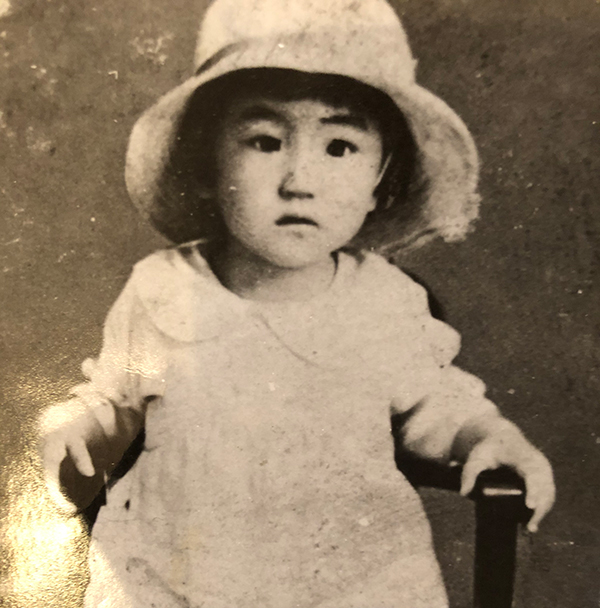
-
- 1932
- Family moves to former Manchukuo. Spends youth in Dalian and Harbin.
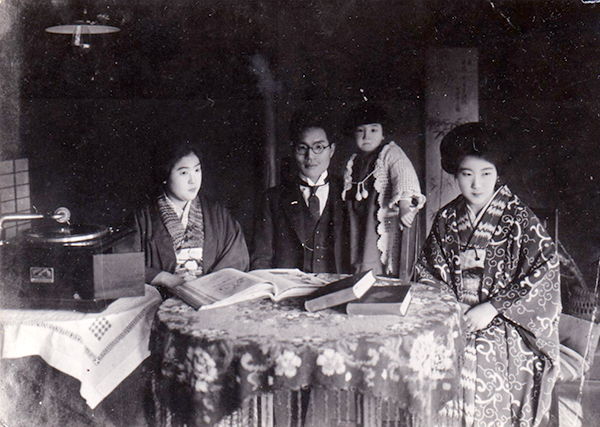
-
- 1938
- Begins studies at Joshibijutsu Senmon Gakko, today`s Joshibi University of Art and Design, leaves the school before finishing the course.
-
- 1939
- Studies at Bijutsu Kogei Gakuin, a school of arts and crafts headed by Toyama Usaburo, Fukuzawa Ichiro, Hasegawa Saburo, and Tanaka Ichimatsu.
-
- 1943
- Evacuates to Shinshu until the war ends.
-
- 1945
- Returns to Tokyo after the war.
-
- 1950
- Active as a member of the Jiyu Bijutsu Kyokai [Jiyu art association] until the early 1970s.
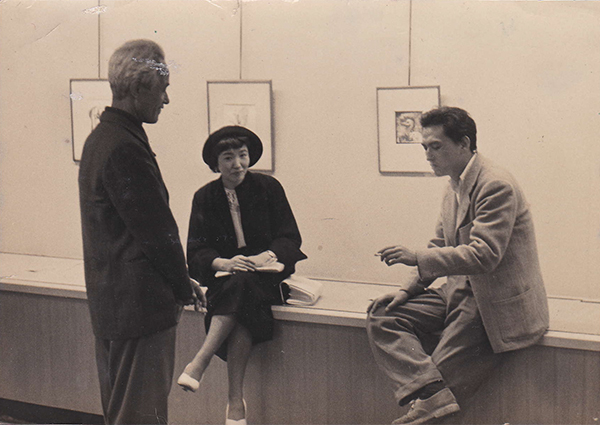
-
- 1953
- Begins work as an illustrator of children’s books. Begins producing paintings and lithographs of coal and mineral mines.
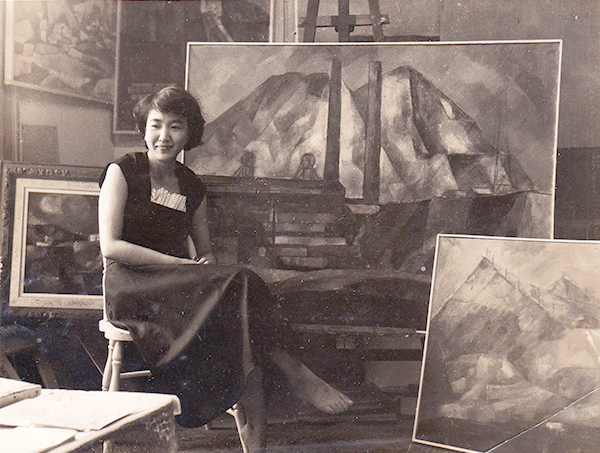
-
- 1954
- Solo exhibitions at Shiseido Gallery in Tokyo and other galleries.
-
- 1961
- Travels to Latin America via the Indian Ocean and the Cape of Good Hope. Visits Brazil, Chile, Mexico, and Cuba.
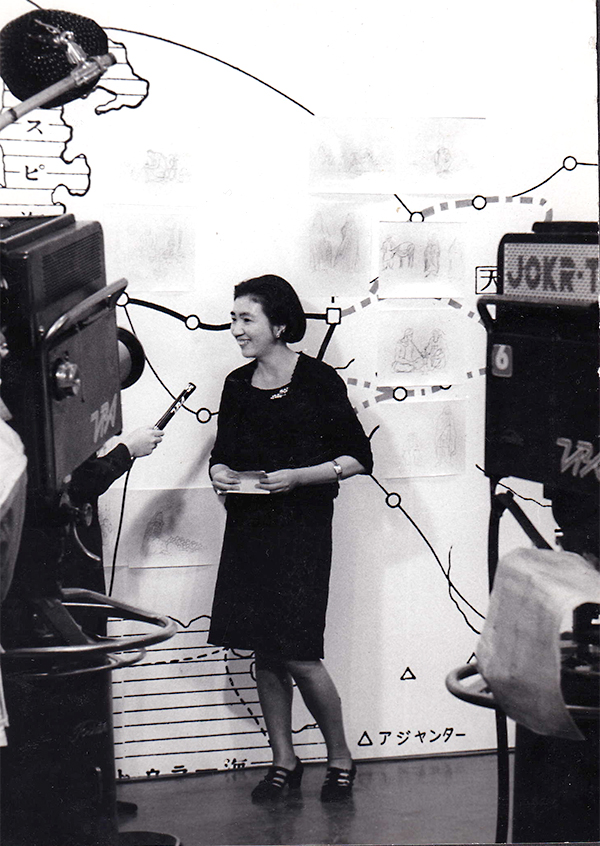
-
- 1967
- Travels to India, the Middle East, and Central Asia.
-
- 1970
- Visits Seoul, reuniting with former classmates.
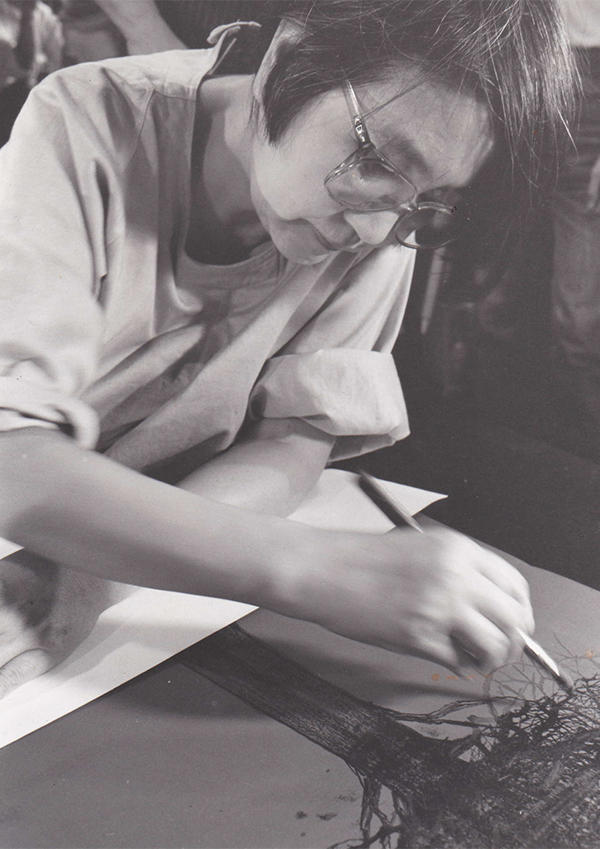
-
- 1971
- Inspired by the poetry of Korean political prisoner, Kim Chi-Ha, begins producing lithographs.
-
- 1972
- Exhibits lithographs inspired by the poetry of Kim Chi-Ha.
-
- 1973
- Publishes Koe yo kesareta koe yo Chile ni [Silenced Voices: Chile], a collection of Tomiyama’s lithographs and poems by Pablo Neruda and Gabriela Mistral.
-
- 1974
- Begins the series of lithographs, Chained Hands in Prayer, based on poems by Kim-Chi-Ha.
-
- 1975
- Exhibits On the Poems of Kim Chi-Ha and Pablo Neruda New York, Chicago, and Berkeley.
Publishes Watashi no girishia shinwa – eros eno kaiki [My Greek mythology—reclaiming eros],
Doshinsha, Tokyo.
-
- 1976
- Contributes lithographs to a television documentary about Kim Chi-Ha that is censored. Staff members produce a series of slides that she takes to America, Canada and Mexico. Publishes Shinya Kim Chi-Ha + Tomiyama Taeko shigashu [At midnight], Doyobijutsusha, Tokyo.
-
- 1977
- Hidane Kobo produces the slide work, Chained Hands in Prayer. Tomiyama launches the Asian Women’s Association together with Matsui Yayori and others.
-
- 1979
- Publishes Kaiho no bigaku —20 seiki no gaka wa nani o mezashita ka [Aesthetics for liberation—what 20th century artists challenged].
-
- 1980
- Produces the series of lithographs, Prayer in Memory: Kwangju, May 1980. An exhibition of the series and the Hidane Kobo slide work of the same title, tours Japan.
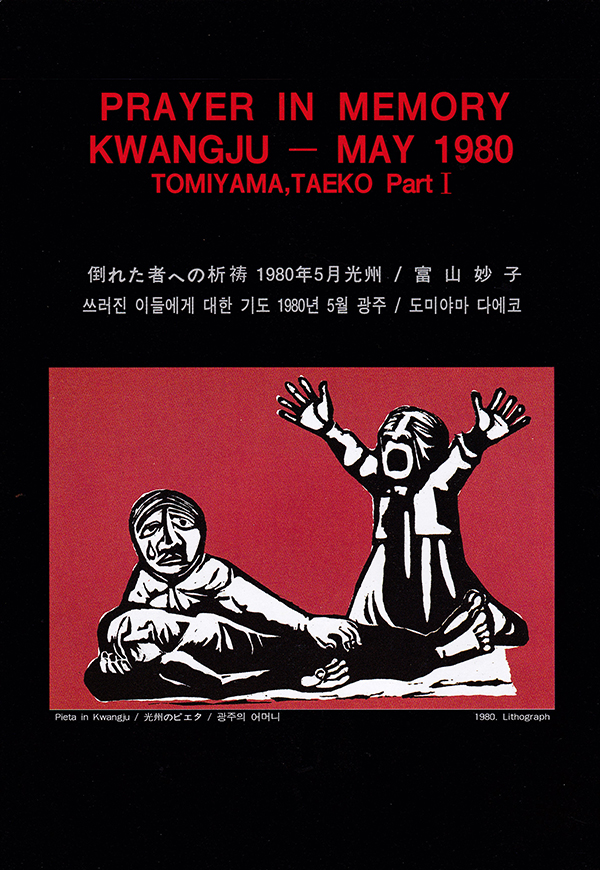
-
- 1981
- The first screening of the film Free Kwangju, May 1980 (Directed by Maeda Katsuhiro, Gentosha and Hidane Kobo).
-
- 1982
- Exhibits Prayer in Memory: Kwangju, May 1980 in Paris, Berlin, Heidelberg, and Munich. Begins the series of lithographs and collages, Hikisakareta monotachi [The Dragged and Divided] which includes works on the forced relocation of Korean laborers and the poet Yun Dong-Ju, who died in the Fukuoka Prison.
-
- 1984
- Tsuchimoto Noriaki directs the film Hajike hosenka — Waga Chikuho, waga Chosen [Pop out balsam seeds — my Chikuho, my Korea] on Tomiyama Taeko’s work. The film shows in Paris, Berlin, and later at the Melbourne International Film Festival.
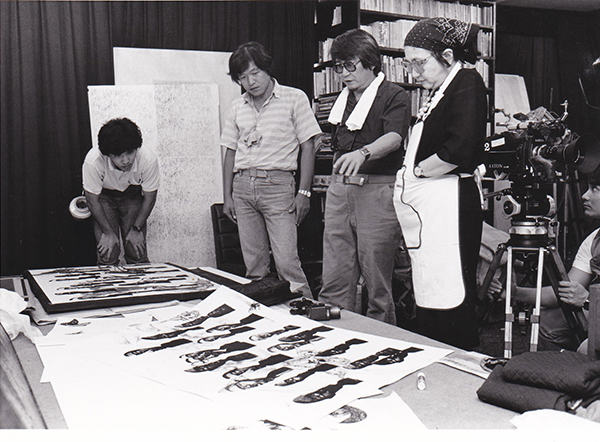
-
- 1986
- Begins oil paintings for the series on the military comfort women, A Memory of the Sea.
-
- 1987
- The play Umi nari hana yose [Roaring of the sea, a gathering of flowers] directed by Satō Makoto, based on the series Memories of the Sea, performed by 68/71 Black Tent Theatre (Gekidan 68/71 Kuro Tento) on the grounds of Tsukiji Hongan-ji temple in Tokyo in May. Two months later the documentary film Umi nari hana yose Showa Nihon: natsu [Roaring of the sea, a gathering of flowers: Summer, Showa Japan] (Gentōsha) directed by Aoike Kenji was completed.
-
- 1988
- Exhibits Tomiyama Taeko’s Work and shows the slide work produced by Hidane Kōbō A Memory of the Sea in London and Berlin.
- Serves as Chairperson of the Sixth JAALA (Japan Asia Africa Latin-American Artist Association),Daisan sekai to wareware ten [The Third World and us—a new wave in Asia] (July) at the Tokyo Metropolitan Art Museum.
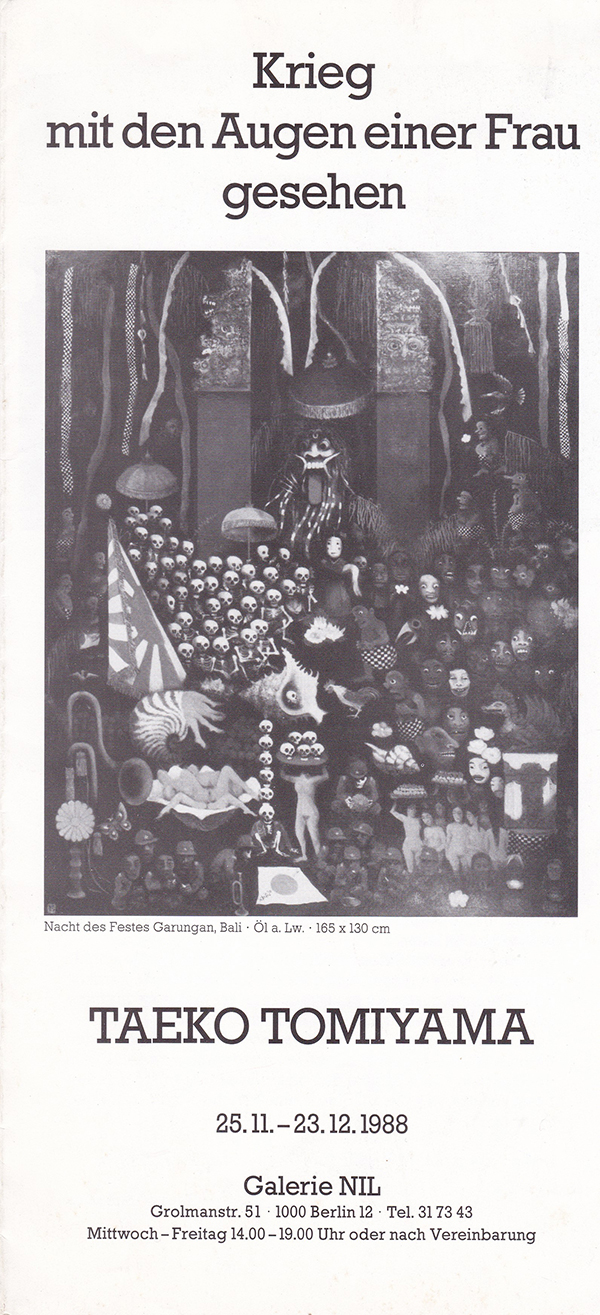
-
- 1989
- Special exhibition Umi nari hana yose by Tomiyama Taeko and Black Tent held at the 15th Hito Hito Ten.
Special exhibition Commemorating the 50th anniversary of World War II in Asia—Tomiyama Taeko in Berlin (May) and Osaka (August). - Special exhibition Tomoshibi ni yoru Tomiyama Taeko sakuhin ten [By the light of lanterns: an exhibition of Tomiyama Taeko’s works] at the Maruki Gallery For The Hiroshima Panels.
- Publishes Sensō sekinin o uttaeru hitori tabi [An appeal to acknowledge war responsibility: a solitary journey to London, Berlin and New York].
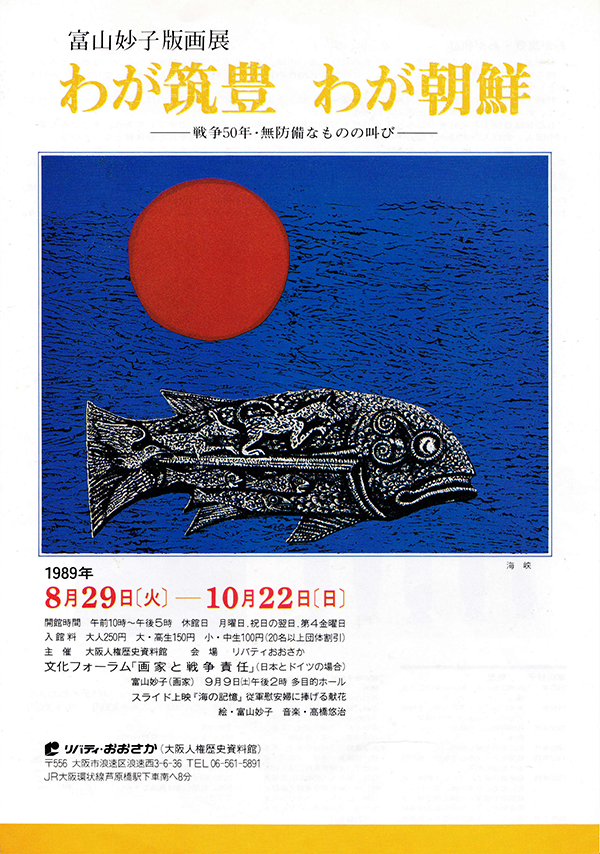
-
- 1990
- Organizes a group called afa (asia feminist art) with like-minded women to hold afa festivals. Tomiyama was actively engaged in the group till 1993.
-
- 1991
- Produces paintings and prints on the theme of Thai women migrant workers in Japan in the series, Let’s Go to Japan! The Thai Girl Who Never Came Home, in collaboration with Jarassri Roopkumdee. Two-person exhibition in Bangkok.
-
- 1992
- Publishes Kaeranu onnatachi —Jūgun ianfu to Nihon bunka [Women who never came home-Military comfort women and Japanese culture] (Iwanami Booklet, Iwanami Shoten).
Exhibits Eros —My Pain: Works by Tomiyama Taeko at the Tama City Feminist Festival. Produces the Hidane Kōbō slide work The Thai Girl Who Never Came Home.
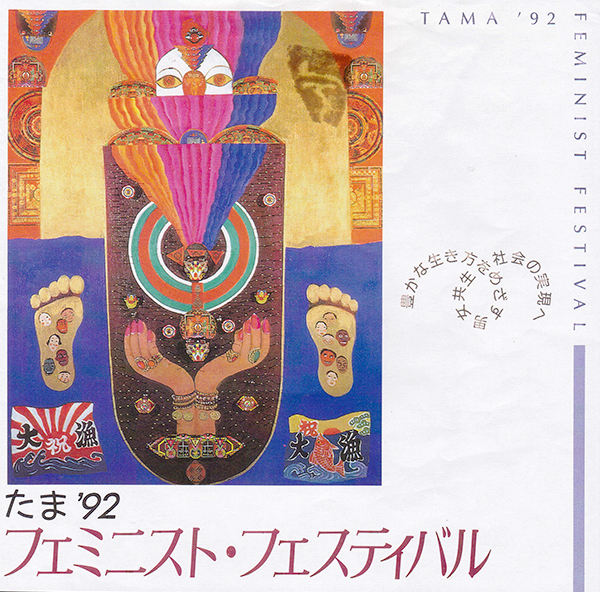
-
- 1993
- Exhibits The Thai Girl Who Never Came Home: An Asian Viewpoint at the Japan Foundation Asia Cultural Center in Tokyo with Jarassri Roopkumdee.
Establishes Asian Women and Art Collective (AWAC) with a group concerned with intersections between art, feminism and war responsibility and holds a series of seminars “Feminizumu no shisō no sōzō no tame ni” (Toward the creation of feminist thought).
AWAC publishes the magazine VISIONS. Publication ends with the bilingual issue, VISIONS: International (no.5).
-
- 1994
- Shows work at the Azabu Museum of Arts and Crafts in the exhibition Josei to Āto. Feminizumu no Chihei ni Mukete [Women and art. Toward the horizon of feminism].
Visits Harbin for the first time in nearly 50 years.
Produces the series Harbin Station: Requiem for the 20h Century, which includes the sub-series of collages, Harbin Station: The Chronicles, serigraphs, Karayuki, Black River, Heaven and Earth, and In the Skies of Eurasia, and oil paintings mounted on scrolls including Sensō, Genshi/War and Illusion.
Publishes Bijutsushi wo tokihanatsu [Setting free art history] from Jiji Press Ltd., co-authored with Hamada Kazuko and Hagiwara Hiroko.
-
- 1995
- Exhibits Tomiyama Taeko’s Work, On the 50th Anniversary of the War: Requiem for the 20th Century: Harbin Station at the Tama Art University Museum (Tokyo, April) and Dong A-Gallery (Seoul, August).
- Publishes silenced by history: Tomiyama Taeko`s work (Gendaikikakushitsu).
Produces the slide work Harbin: Requiem for the 20th Century (Hidane Kōbō). - Invited to exhibit in the Special Exhibition, The Spirit of Kwangju Resistance in May at the 1st Kwangju Biennale, in South Korea.
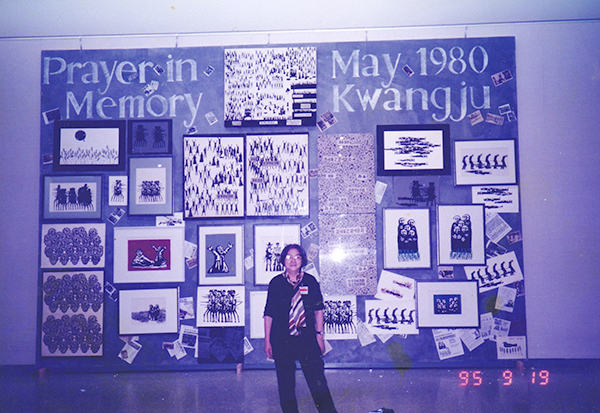
-
- 1997
- Solo exhibition Requiem for the Military Comfort Women: Works by Tomiyama Taeko at Liberty Osaka (the Osaka Human Rights Museum).
-
- 1998
- Holds two-artist exhibition From the Asians: Tomiyama Taeko and Hong Sung-dam at the Mangwoldong Gallery (Gwangju, May), at the Puchon City Hall (November), and at the Kawasaki Education Center (Kanagawa, December).
-
- 2000
- Invited to exhibit an installation of Prayer in Memory and the series The Fox Story in the Special Exhibition “Art and Human Rights”at the 3rd Kwangju Biennale.
- Exhibits The Fox and the Mines: Artists Look at Myth and Reality in Contemporary Japan in collaboration with poets, photographers and musicians at the Life Style Design Center, Carrot Tower, Setagaya, Tokyo.
- Publishes Girishia Shinwa [Greek myths], text by Ishii Momoko, illustrations by Tomiyama Taeko.
-
- 2001
- Holds event to commemorate the 25th anniversary of Hidane Kōbō and presents a plan for the work that will later will become Hiruko and the Puppeteers: A Tale of Sea Wanderers.
- Shows The Fox Story (Hidane Kōbō).
- Exhibits The Fox and the Coal Mines at ACROS Fukuoka.
- Exhibits Tomiyama Taeko — Let’s Go To Japan at Truscon Garden in Seikei University, Tokyo.
-
- 2002
- Exhibits The Shaman and the Fox: Tomiyama Takeo’s Art at Gallery Fleur, Kyoto Seika University.
- 80 works from the series, Kwangju, enter the collection of the Ha Jung-woong Museum of Art (Kwangju).
-
- 2004
- Publishes Kero Kero Kororo (Fukuinkan Shoten, Tokyo) with text and music by Takahashi Yuji.
- Exhibits collages and prints in Remembrance and Reconciliation: Tomiyama Taeko’s Art at Ruhr University (Bochum, Germany), the International House and Temple University (Philadelphia) and the Dittmar Gallery, Northwestern University (Evanston) (until Feb, 2006).
-
- 2005
- Invited to the 9th Women’s Worlds Conference at Ewha Womans University in Seoul to show slide works produced by Hidane Kōbō and lecture.
- Exhibits Tomiyama Taeko, Takahashi Yuji: e to ongaku to gentō no hiroba [Tomiyama Taeko and Takahashi Yuji. A space for painting, music and magic lanterns] at the Korai (Korea) Museum (Tokyo).
- Exhibits work in Zen’ei no josei 1950-1975/Japanese Women Artists in Avant-garde Movements, 1950-1975, Tochigi Prefectural Museum of Art.
- Exhibits Tomiyama Taeko: Requiem for the 20th Century memories and collages at the Japan Education Hall, Hitotsubashi Gallery (Tokyo).
Gives “The Third Chino Kaori Memorial ‘New Visions’ Lecture” in Tokyo.
-
- 2006
- Publishes 20 seiki e no requiem: e to ongaku ga de atte jidai no koe o tsugeru/Requiem for the 20th Century: Paintings and Music Come Together to Tell the Tale of an Era. Medieval Japanese Studies Institute, Kyoto.
-
- 2007
- Reunites with Park In-kyung, wife of the late Lee Ungno at the opening ceremony of the Musée LEEUNGNO (Korea, Photo by Mika Furukawa).
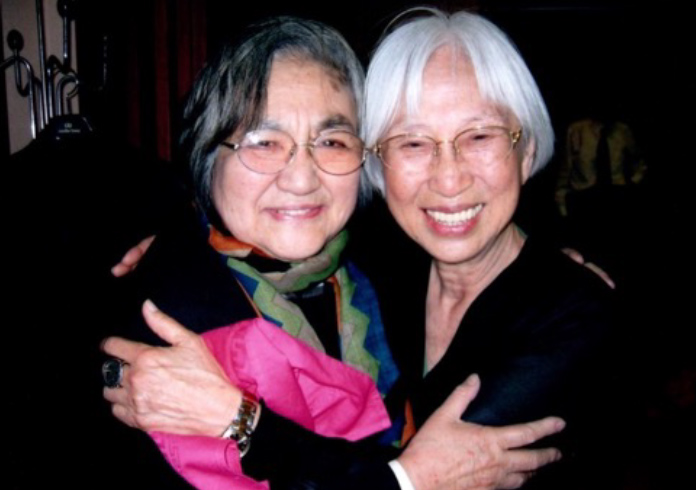
-
- 2008
- Exhibits artwork at Art de hyōgensuru YASUKUNI [Expressing YASUKUNI through art] at the Japan Education Center Hall, Hitotsubashi Gallery (Tokyo).
-
- 2009
- Publishes Ajia o idaku: gaka jinsei kioku to yume [Embracing Asia: An artist’s life. memories and dreams] (Iwanami Shoten, Tokyo).
- Exhibits Black River from the Harbin Series in Kinkyū ōto akushon 2009 [Emergency art action 2009], Gallery Maki (Tokyo).
- Publishes Hiruko and the Puppeteers: A Tale of Sea Wanderers (with DVD, Gendaikikakushitsu, Tokyo).
- Exhibits early oil paintings in The Coal Mines as Cultural Resource: Art/Photography/Graphic Arts/Film and Japanese Coal Mines, Meguro Museum of Art.
-
- 2010
- Exhibits Ajia o mitsumete. Shokuminchi toTomyama Taeko no gaka jinsei [Tomiyama Taeko: an artist looking back at colonialism], Tokyo YWCA.
- Imagination Without Borders—Feminist Artist Tomiyama Taeko and Social Responsibility published by Center for Japanese Studies, University of Michigan .
- Kwangju (Gwangju) series exhibited at the 2010 Special Symposium “Resistance and Peace” to commemorate the 30th anniversary of the Gwangju Uprising, cosponsored by the May 18 Institute, Chonnam National University and the Peace Studies Association of Japan.
-
- 2011
- Begins working on the series Revelation from the Sea.
- Gives five public interviews in the series “Onna tachi no kioku e no tabi” [A journey through women’s memories], sponsored by VAWWRAC (until 2012).
-
- 2012
- Exhibits 3.11 Tomiyama Taeko no e ni yoru messēji [3.11 Tomiyama Taeko’s message through art] at the symposium Saigai fukkō kyoten to shite no josei sentā [Women’s centers as a space for disaster relief] at the Employment Support Center for Women (Tokyo).
- Exhibits artwork and participates in Korean Diaspora no kioku o taguru: `gisei no
jōkyō’ o koete [Retrieving memories of the Korean diaspora -beyond the “situation of sacrifice”] – at an international symposium at the Institute of Industrial Science, the University of Tokyo (March 3). - ExhibitsTomiyama Taeko’s Works: Exhibition and Lecture-Earthquake, War, Woman held at the Raiosha Gallery, Keio Research Center for the Liberal Arts.
- Exhibits Tomiyama Taeko no messēji ten—3.11 o mitsumete [Message from Tomiyama Taeko: Looking at 3.11] at Hachimanyama no Yokan, Hiratsuka, Kanagawa.
-
- 2013
- Exhibits Tomiyama Taeko: Gendai e no mokuji —9.11 to 3.11 [Tomiyama Taeko: Revelation for the modern era—3.11-9.11], Tokyo Art Museum, Chofu.
- Publishes < Otoko Bunka > yo, saraba —shokuminchi, sensō, genpatsu o kataru [Farewell to ‘male culture’—Talking about colonialism, war and nuclear power], co-authored with Shin Sugok (Iwanami Booklet, Iwanami Shoten, Tokyo).
- Exhibits < Otoko Bunka > yo, saraba —Shin Sugok and Tomiyama Taeko [Farewell to ‘male culture’—Shin Sugok and Tomiyama Taeko] at the Korean YMCA in Japan, Tokyo.
-
- 2014
- Produces DVD work Umi kara no mokuji/Revelation from the Sea (Hidane Kōbō).
- Gives lecture “Ātisuto Tomiyama Taeko ga kataru—watashi no sensō, sengo, soshite Fukushima” [“The artist, Tomiyama Taeko speaks: my war, post war, and Fukushima”] , Miyazaki Municipal University, Miyazaki.
-
- 2015
- Exhibits works in the group show Verbotene Bilder: Kontrolle und Zensur in den Demokratien Ostasiens/Banned Images: Control and Censorship in East Asian Democracies, nGbK, Berlin.
-
- 2016
- Exhibits Special exhibition: Tomiyama Taeko. Owari no hajimari, hajimari no owari [Special exhibition: Tomiyama Taeko. Beginning of the end, end of the beginning], Maruki Gallery for the Hiroshima Panels, Saitama.
-
- 2017
- Exhibits works in Truth: Promise for Peace, a group show held at The National Women’s History Exhibition Hall, Seoul, South Korea.
-
- 2019
- Exhibits Tomiyama Taeko sakuhin sekai 1980-2014: Owari no hajimari, hajimari no owari II [Tomiyama Taeko’s works: Beginning of the end, end of the beginning, part II], Fujino Club, Sagamihara, Kanagawa.
-
- 2020
- Invited to exhibit work in Unflattening, marking the 70th anniversary of the Korean War at the National Museum of Modern and Contemporary Art (MMCA), Seoul.
-
- 2021
- Exhibits work in Nihon Indépendent ten to josei sakkatachi [The Japan Indépendent Exhibition and female artists] (March) , National Art Center, Tokyo.
- Exhibits To Turbulent Seas of Memory —The World of Tomiyama Taeko (March – August), Yonsei University Museum, Seoul.
- Speaks (online) at the opening ceremony for the exhibition To Turbulent Seas of Memory — The World of Tomiyama Taeko, Yonsei University Museum, Seoul.
- Receives Medal of Honor from the South Korean Government for her contribution to the Korean Democracy movement (June).
- Passes away in her home and studio in Tokyo at the age of 99 (August 18).
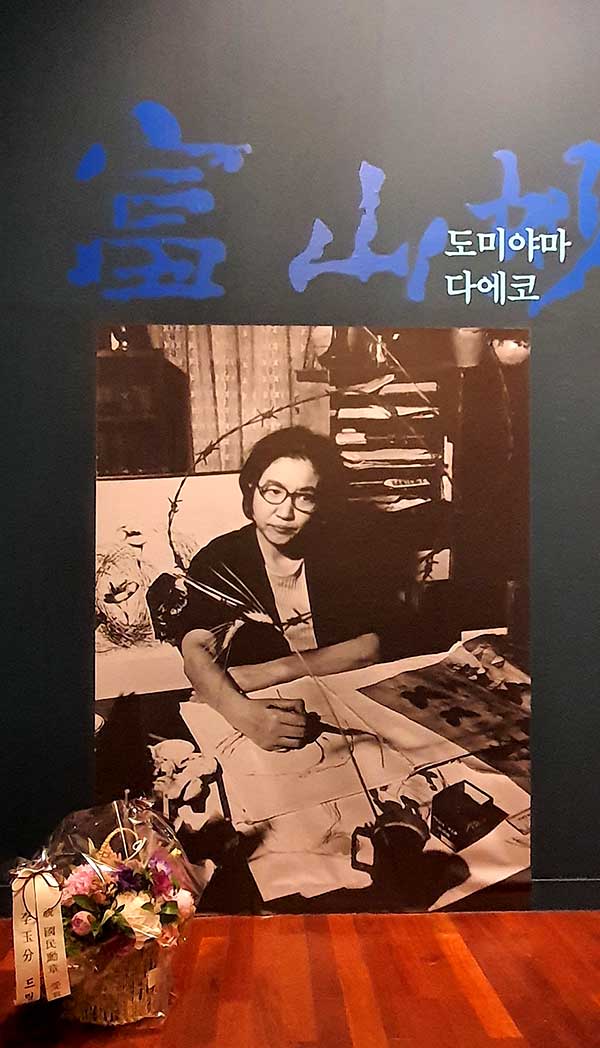
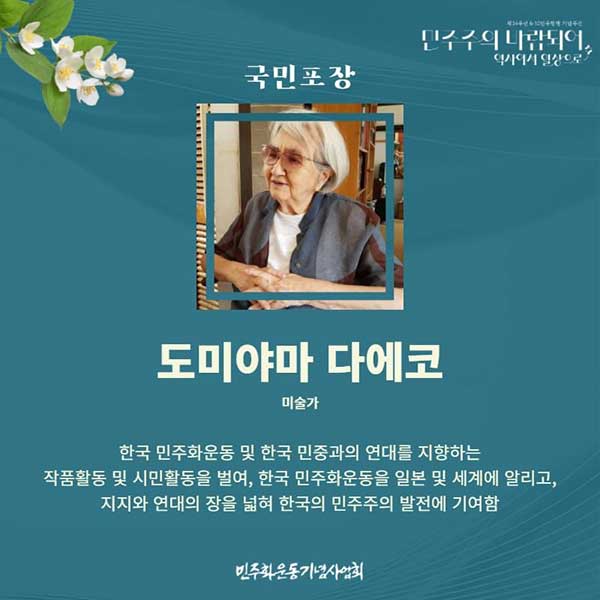

-

Now Loading...
